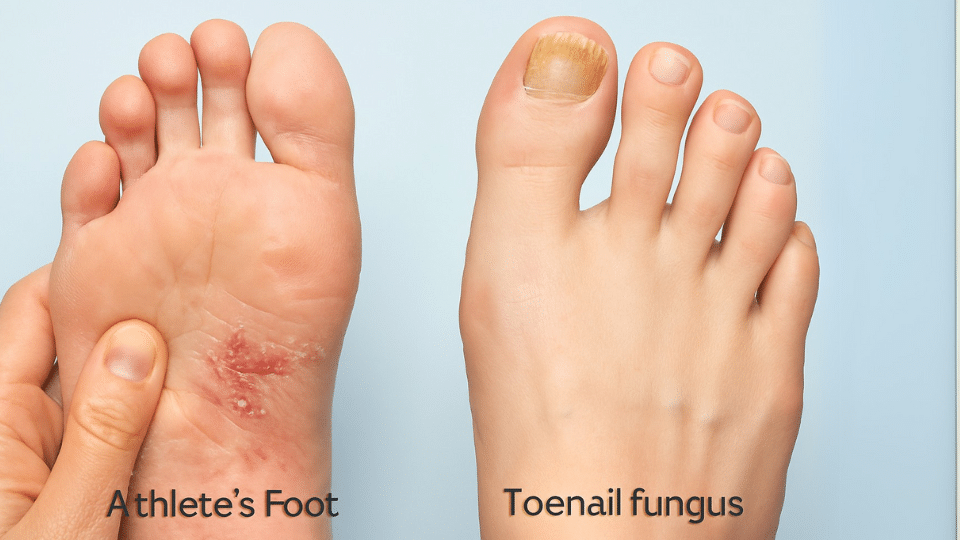Both athlete’s foot and nail fungus are common fungal infections that affect the feet, causing discomfort, embarrassment, and even more serious health issues if left untreated. Though they share some similarities, there are distinct differences between these two conditions that are important to understand for proper treatment and prevention.
In this article, we’ll explore the difference between athlete’s foot and toenail fungus, their causes, symptoms, and effective treatment options, so you can confidently take steps toward healthier feet.
What is Athlete’s Foot?
Athlete’s foot is a fungal infection that typically affects the skin on the feet, particularly between the toes. It is caused by a group of fungi known as dermatophytes, which thrive in warm, moist environments, such as sweaty shoes and locker rooms.
Symptoms of Athlete’s Foot
- Itching and burning between the toes or on the soles of the feet.
- Red, scaly rash that may peel or crack.
- Blisters that can ooze or crust over.
- Stinging or burning sensation, especially when walking.
Athlete’s foot is highly contagious and can be spread through direct contact with infected surfaces, such as showers, pools, and communal gym equipment. It’s important to treat it promptly to avoid spreading the infection to others or developing secondary infections.
Treatment for Athlete’s Foot
- Topical antifungal creams: Over-the-counter antifungal treatments like clotrimazole or terbinafine can effectively treat athlete’s foot.
- Antifungal powders and sprays: These can help keep the feet dry and prevent further fungal growth.
- Proper foot hygiene: Wash feet regularly, dry thoroughly (especially between toes), and wear breathable socks and shoes to reduce moisture buildup.
- Prescription antifungal medications: For severe or persistent infections, a podiatrist may prescribe oral antifungal medications.
What is Toenail Fungus?
Toenail fungus, or onychomycosis, is a fungal infection that affects the nails, causing them to become discolored, thickened, and brittle. It’s typically caused by dermatophytes, yeasts, or molds, which invade the nail bed and grow under the nail, leading to infection.
Symptoms of Toenail Fungus
- Discoloration of the nail, often turning yellow or white.
- Thickening of the nail, making it difficult to trim.
- Brittle or crumbling nails that may have a distorted shape.
- Foul odor from the infected nail.
- Pain or discomfort, particularly when pressure is applied to the affected nail.
Toenail fungus tends to develop slowly, so it can be challenging to notice in its early stages. If left untreated, it can spread to other nails or become more difficult to treat, requiring more invasive procedures.

Treatment for Toenail Fungus
- Topical antifungal treatments: Antifungal nail lacquers like ciclopirox can be used to treat mild infections.
- Oral antifungal medications: Prescription medications like terbinafine or itraconazole may be necessary for severe cases.
- Laser treatments: Some podiatrists offer laser therapy to target the fungal infection under the nail.
- Nail removal: In rare cases, if the infection doesn’t respond to other treatments, nail removal may be necessary.
Check out our guide on recognizing the signs of healing in toenail fungus, which also explores laser toenail fungus treatment as an effective option for eliminating the infection for good.
Key Differences Between Athlete’s Foot and Toenail Fungus
Understanding the difference between athlete’s foot and toenail fungus is crucial for proper diagnosis and treatment. Although both are fungal infections, their symptoms, affected areas, and treatment approaches vary.
Feature | Athlete’s Foot | Toenail Fungus |
Location | Affects the skin on the feet, particularly between toes | Affects the toenails, usually starting at the edges |
Symptoms | Itching, burning, redness, blisters, peeling skin | Discoloration, thickening, brittleness, foul odor |
Spread | Highly contagious, often spread in public spaces | Can spread from one nail to another, but less contagious |
Treatment | Antifungal creams, powders, sprays | Antifungal lacquers, oral medications, or laser treatment |
Causes | Caused by dermatophytes thriving in warm, moist areas | Caused by dermatophytes, yeasts, or molds affecting nails |
How to Prevent Athlete’s Foot and Toenail Fungus
Both athlete’s foot and nail fungus can be prevented with simple hygiene habits and foot care practices. Here are some tips to keep your feet fungus-free:
Maintain Good Foot Hygiene
- Wash your feet daily with soap and water.
- Dry your feet thoroughly, especially between the toes.
- Use antifungal powder or spray to keep your feet dry and free from fungal growth.
Choose Proper Footwear
- Wear shoes made from breathable materials like leather or mesh to allow air circulation.
- Avoid tight-fitting shoes that can trap moisture and heat.
- Alternate shoes to allow them to dry out completely between wear.
Learn more about choosing the right shoes by visiting our guide on Shoes, Shoes, Shoes.
Use Antifungal Products
- If you are prone to athlete’s foot or toenail fungus, consider using antifungal foot sprays or powders regularly to prevent infection.
Protect Your Feet in Public Spaces
- Always wear flip-flops or waterproof shoes when walking in public pools, locker rooms, or showers.
Trim Your Toenails Properly
- Keep your toenails trimmed short and straight to prevent injury, which can lead to infections.
- Avoid cutting nails too short or rounding the edges, as this can cause ingrown toenails and increase the risk of fungal infections.
Be sure to follow our guide on Proper Nail Trimming to keep your toenails healthy and free from fungal infections.
Conclusion: Keep Your Feet Healthy and Fungus-Free
Athlete’s foot and toenail fungus are treatable conditions, but early intervention is crucial to prevent them from worsening. By understanding the difference between athlete’s foot and toenail fungus, you can take proactive steps to prevent and manage these infections. Remember, if symptoms persist or worsen, seeking professional care from a podiatrist is the best way to ensure you get the treatment you need for healthy, fungus-free feet.
If you want to know more about these conditions, you can check here.
When to Seek Professional Care
If you suspect you have athlete’s foot and nail fungus, it’s important to consult with a podiatrist for a proper diagnosis and treatment plan. If left untreated, both conditions can lead to more severe complications, such as spreading the infection to other parts of the body or causing permanent nail damage.
Whether it’s a simple case of athlete’s foot or a stubborn toenail fungus, we’re here to help you get back to healthy, pain-free feet. At Fall Creek Foot & Ankle, our expert podiatrists specialize in accurate diagnosis and effective treatment.
Contact us today to schedule an appointment and get the expert care you need.
